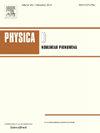Slushball Earth equilibria in a one-dimensional energy balance model
IF 2.9
3区 数学
Q1 MATHEMATICS, APPLIED
引用次数: 0
Abstract
Understanding the widespread glaciations of the late Neoproterozoic era (715–635 Ma) is important for understanding the evolution of life on Earth. A Waterbelt state has been proposed as a more biologically friendly alternative to the Snowball Earth hypothesis. It was subsequently shown that an open tropical ocean can be sustained by a so-called “Jormungand mechanism”, where darker, bare sea ice at the descending edge of the Hadley cell halts the runaway ice-albedo feedback synonymous with Snowball Earth. However, the geological evidence for thick, active glaciers at sea level in the deep tropics during these glaciations presents a problem for the Waterbelt hypothesis that has received limited attention in the literature. We study a diffusive, one-dimensional energy balance model (EBM) with a Jormungand mechanism, where also the effects at the ascending edge of the Hadley cell are included. The EBM is solved using an analytical approach, the boundary integral method. The modified Jormungand mechanism produces several unstable Slushball Earth states in the EBM, in addition to the Waterbelt states. These Slushball Earth states are similar to Snowball Earth, but with a series of water belts over lower latitudes. Implications for the Neoproterozoic glaciations are discussed.
一维能量平衡模型中的泥球地球平衡
了解新元古代晚期(715-635 Ma)广泛的冰川作用对理解地球上生命的进化具有重要意义。与雪球地球假说相比,人们提出了一种对生物更友好的水带状态。随后的研究表明,开放的热带海洋可以通过所谓的“Jormungand机制”来维持,在那里,哈德利小圈下降边缘的深色、裸露的海冰阻止了失控的冰反照率反馈,这与雪球地球是代名词。然而,在这些冰期期间,深热带地区海平面上厚而活跃的冰川的地质证据对文献中受到有限关注的水带假说提出了一个问题。我们研究了一个具有Jormungand机制的扩散的一维能量平衡模型(EBM),其中也包括了Hadley cell上升边缘的影响。用一种解析的方法——边界积分法来求解EBM。改进的Jormungand机制在EBM中产生了几种不稳定的Slushball Earth状态,除了水带状态。这些“泥球地球”类似于“雪球地球”,但在低纬度地区有一系列的水带。讨论了新元古代冰川作用的意义。
本文章由计算机程序翻译,如有差异,请以英文原文为准。
求助全文
约1分钟内获得全文
求助全文
来源期刊

Physica D: Nonlinear Phenomena
物理-物理:数学物理
CiteScore
7.30
自引率
7.50%
发文量
213
审稿时长
65 days
期刊介绍:
Physica D (Nonlinear Phenomena) publishes research and review articles reporting on experimental and theoretical works, techniques and ideas that advance the understanding of nonlinear phenomena. Topics encompass wave motion in physical, chemical and biological systems; physical or biological phenomena governed by nonlinear field equations, including hydrodynamics and turbulence; pattern formation and cooperative phenomena; instability, bifurcations, chaos, and space-time disorder; integrable/Hamiltonian systems; asymptotic analysis and, more generally, mathematical methods for nonlinear systems.
 求助内容:
求助内容: 应助结果提醒方式:
应助结果提醒方式:


